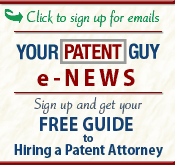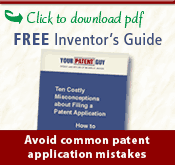It has finally happened – patent “reform” has been passed by both the US House of Representatives and the US Senate, and President Obama is expected to sign this legislation. My opinion is that this is typical of “major” legislation in this day and age, no coherent, long-term view to solving real problems. The US Patent system does have problems, and this legislation doesn’t address them, and may make matters worse, particularly for small inventors.
But we have to play the hand we’re dealt, so let’s dive in and see what’s up.
There are a large number of changes to the patent law, some of the major changes will not be effective until much later (e.g., 1 year out and 18 months out from enactment). I’ll discuss changes to the reexamination (most changes 1 year out) and first inventor to file (18 months out) in later posts.
What is on deck on the day of enactment?
Fees, and some other stuff.
Fees:
One of the big “fights” was about fee diversion and whether the USPTO could set its fees, and retain the fees that inventors pay. Some programs have been discontinued because of fee diversion issues, and some people claim that one of the reasons that patent reform is necessary is because the USPTO is understaffed/underfunded to do a good job. Having more people and a better trained workforce would appear to be desirable for any business and undoubtedly this could apply in some fashion to the USPTO.
The new legislation gives the USPTO Director fee setting authority, continues the practice of small entities receiving a 50% discount, and introduces the concept of a micro-entity. A micro-entity receives a 75% discount! To qualify as a micro-entity, you need to (1) meet the requirements of the regulations to be issued by the Director, (2) have not been named on more than 4 patent applications (other than foreign, provisional, or international applications), (3) not have a gross income more than 3x the median household income for the preceding year, and (4) has not assigned the application to an entity whose income exceeded that amount.
Can you believe “grown-ups” sat around and argued over this stuff? Typically the USPTO fees are not a significant impediment to filing, prosecuting, enforcing, and otherwise monetizing an invention. Over the long haul, these fee reductions could add up, but you cannot be a micro-entity for the long haul. And without implementing regulations (1) above, it could be some time until this discount is available.
Interestingly, the legislation includes implementation of a 15% surcharge on all statutory fees 10 days after enactment. Stay tuned for details. I don’t believe that there will a window for micro-entities to pay reduced fees without the surcharge, mostly because I do not believe that the regulations have been completed. This surcharge is terminated once the Director exercises his authority to set fees. Optimistically, this is at least 18 months out.
There is also implementation of the Prioritized Examination where you get to bump your application to the front of the queue (with conditions, including payment of $4,800). I suspect that there will be a 15% surcharge and maybe a reduction for small/micro entities. We’ll see soon enough.
Other stuff:
1. Best Mode is no longer a defense to infringement. As a patent drafter we’re still supposed to include the best mode contemplated by the inventor of carrying out the invention. This may advance the cause of global harmonization as most other jurisdictions do not require this, but at least in theory the failure of the legislation to remove the best mode requirement from 35 USC Section 112 means that the US inventor may be at a disadvantage. You need to disclose the best mode (albeit perhaps without consequence if you don’t, I’ll be asking you for it in any case), while other inventors from outside the US likely will not be disclosing their best modes.
2. Virtual marking will arrive. Rather than having to mark a patented product with the patent number, a patentee will have the option to use an Internet address that associates the patented article with the number of the patent. The access has to be without charge.
3. Patent Term Extension – this doesn’t apply to you unless you are the well-connected law firm of WilmerHale and are trying to avoid a hefty malpractice claim. They will tell you that this arcane carve-out could help anyone and that this is only backup because a court has ruled that the WilmerHale firm did not file a day or two too late. If it were the key to WilmerHale avoiding a malpractice claim, it is reportedly worth several hundreds of millions of dollars. Big bonuses for the partner responsible for this.
4. Tax strategies – No longer will you be able to get protection for your invention related to any strategy for reducing, avoiding, or deferring tax liability, whether known or unknown at the time of invention or the filing of a patent application. Unfortunately Congress has already implemented its strategy of reducing tax liability – strangling the economy – but that is another story and they don’t appear to trying to patent their brand of governance.
5. Human organisms – this ruined my plan to self-patent YourPatentGuy. (Not that I wanted a patent number tattooed on my backside.) Actually, the annual budget process for the USPTO included a prohibition against obtaining any patent on a claim directed to or encompassing a human organism. This change in current law makes it so this prohibition is permanent and not part of the annual dance. People are concerned that this language is broader and may work against patenting DNA.
6. Reexamination – While most changes are 1 year off, there is a tweak that happens immediately. The current standard that the USPTO applies when determining whether to grant a reexamination request is to determine whether there exists a “substantial new question of patentability” – and the USPTO has been famous for answering in the affirmative almost every time someone asked. Upon enactment, there will immediately be a change to this standard so that requestors will have to show “a reasonable likelihood that the requester would prevail with respect to at least 1 of the claims challenged in the request.”
Further with respect to ex parte reexaminations, on the date of enactment, you can no longer ask a district court to review an ex parte reexamination decision that you are unhappy about.









{ 4 comments… read them below or add one }
Strict Standards: Only variables should be assigned by reference in /home/k13x1mpx8le9/public_html/ypg/wp-content/themes/thesis_185/lib/classes/comments.php on line 187
I keep hoping for some sweeping legislation that will put the country back on track. Like First Action in 2 months. Oh well.
Brad, that would be something! Prioritized applications may be the ticket for you – first action in 12 months. (But there is that $4,800 fee – $2,400 for Small Entities.)
Small and micro entities are not eligible for a statutory fee discount for Prioritized Examination.
Discounts for PTO fees are typically important for start-ups, small companies, universities, etc. Some applicants resist switching from small to large entity status when they license or assign their patents to large companies or have been bought by a larger corporation. For more expensive fees, such as, issue and maintenance fees, the small and micro entity discount will make a difference.
Lisa,
Thank you for your clarification. Reduced fees do add up. The new legislation does define qualifying institutions of higher education as micro entities. That will help universities for the reasons you state. I do wish that the patent reform was more fundamental to help all inventors quickly obtain protection and to make evaluation of claim scope and validity much simpler and more predictable.
Regarding prioritized examination, it is my understanding that the program that the USPTO announced earlier this year did not include any discount for a small entity. However, the new legislation appears to change this and expressly authorizes a discount for small entities: “..(h)(2) REDUCTION IN FEES FOR SMALL ENTITIES.—The Director shall reduce fees for providing prioritized examination of nonprovisional applications for original utility and plant patents by 50 percent for small entities that qualify for reduced fees under section 41(h)(1) of title 35, United States Code.” That will be nice. I can understand why there would not be a micro entity discount for this.
What is interesting to me is how micro entity is defined in 2 distinct parts in the legislation. The first part is that a micro entity is a small entity, with additional conditions. The second part simply says that qualifying institutions of higher learning are deemed to be micro entities with the correct certification. If there are situations where there is a small entity status discount, but not a micro entity status discount (I believe such may be the case for prioritized examination), then these institutions would appear to have to pay the full undiscounted fee if they don’t otherwise qualify for small entity status.